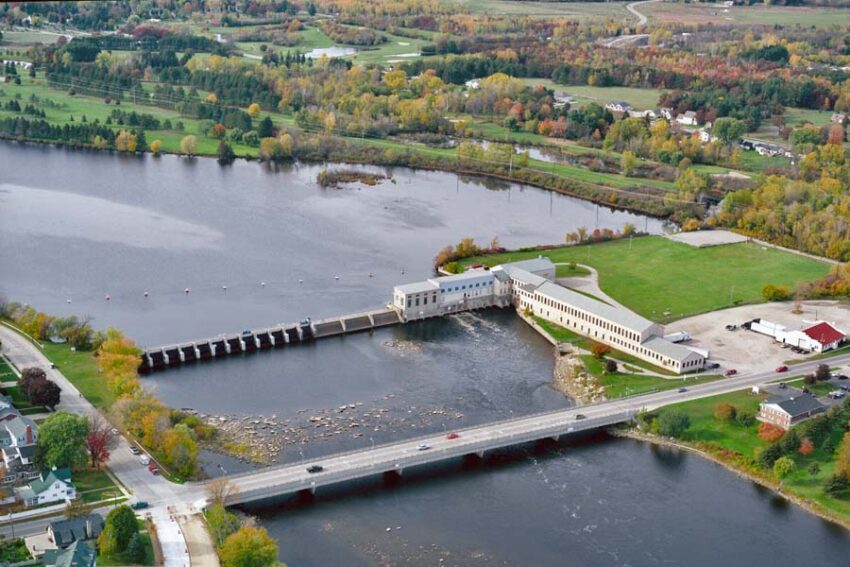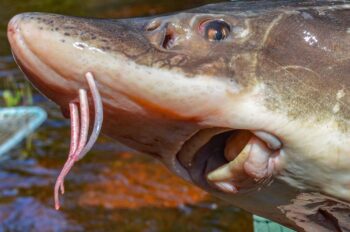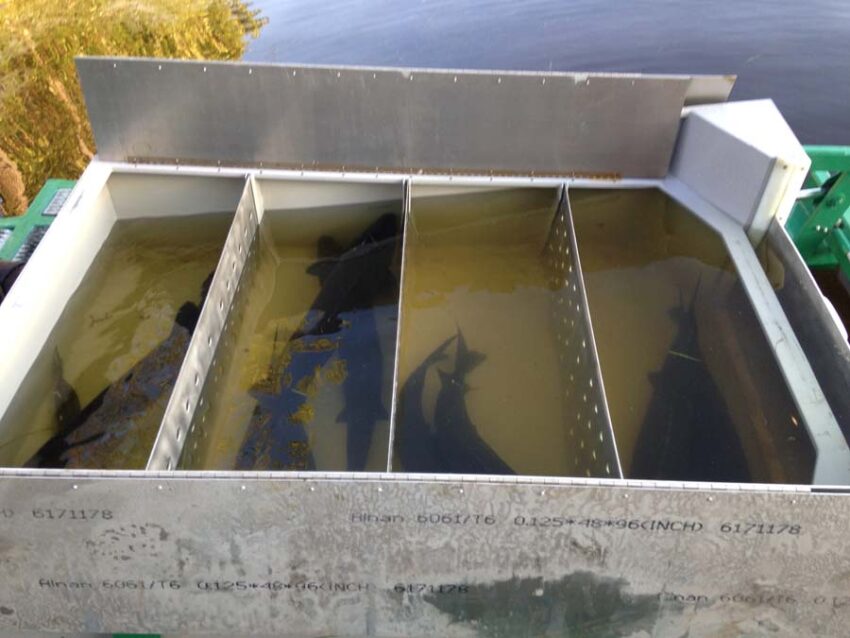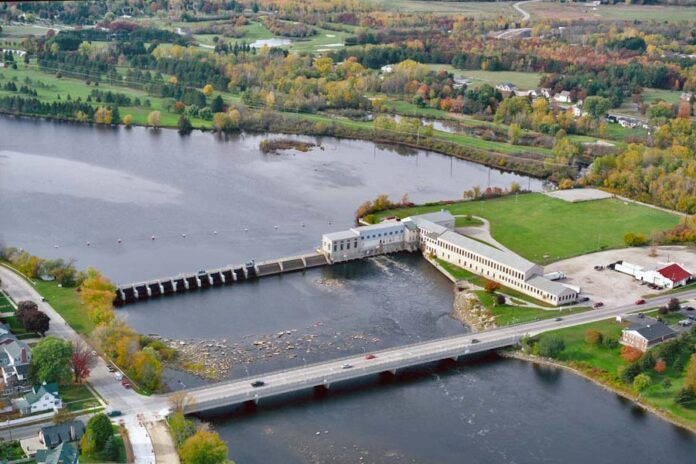
By JENNIFER JOHNSON and DARREN KRAMER, Michigan Department of Natural Resources
MICHIGAN – Lake sturgeon are a long-lived fish species that were once common throughout the Great Lakes.
However, over the last two centuries, lake sturgeon populations have significantly declined due to several factors, including habitat loss from dam construction. Once numbering in the millions in the Great Lakes region, the lake sturgeon population has now been reduced to a few thousand fish. The lake sturgeon is currently listed as a threatened species in Michigan.
The Menominee River, forming part of the border between Wisconsin and Michigan in the Upper Peninsula, is a large tributary to Green Bay on Lake Michigan and supports one of the largest remaining populations of lake sturgeon in the Great Lakes. The sturgeon here number roughly 1,200 adult fish – compared to roughly 20,000 to 25,000 historically.
Before construction of several hydroelectric dams throughout the Menominee River during the 19th century, lake sturgeon migrated upstream from Green Bay for approximately 70 miles to spawn, before encountering a natural barrier at Sturgeon Falls in Dickinson County.
Currently their access to the river is cut short by the Menominee Dam, which is located approximately 2.5 miles upstream from Green Bay. A second dam, Park Mill, is located only about 1 mile upstream of the Menominee Dam.
Mature, adult lake sturgeon need specific spawning habitat typically found in rivers and are willing to make long migrations to reach those optimal spawning locations.

“Dams are considered one of the greatest impediments to successful sturgeon recovery efforts in the Great Lakes because adult fish are unable to access river spawning habitat and critical habitat needed to support juvenile fish,” said John Bauman, fisheries biologist for the Michigan Department of Natural Resources.
The lack of suitable lake sturgeon spawning habitat and juvenile rearing habitat downstream of the Menominee Dam are likely key factors limiting the rehabilitation of the lake sturgeon population.
Luckily for the lake sturgeon, there is ample habitat for both adults and juveniles above the Park Mill Dam up to the Grand Rapids Dam, situated approximately 19 miles upstream.
Given these facts, the question for fisheries managers was how to reconnect adult lake sturgeon from the lower Menominee River to the abundant spawning and rearing habitats upstream of the two dams?
In some situations, dam removal may be an option to restore river access if the dam has outlived its usefulness. However, Menominee and Park Mill hydroelectric dams are viable producers of renewable energy and not candidates for removal.
So, if the dams can’t be removed, how can lake sturgeon access be restored to upstream habitats in the Menominee River?
It took a creative and talented team to think of a novel, first-of-its-kind idea.
In the early 2000s, a collaborative partnership among Eagle Creek Renewable Energy (owner of Menominee and Park Mill dams), the U.S. Fish and Wildlife Service, the Wisconsin and Michigan departments of natural resources, and the River Alliance of Wisconsin formed the Michigan Hydro Relicensing Coalition to determine how to best address reconnecting adult lake sturgeon from the lower Menominee River with habitats upstream.
The overarching goal of the effort was to increase lake sturgeon recruitment – the process by which small, young fish survive to larger, older fish. It was presumed that these recruits would survive and contribute as adults to the overall sturgeon population in Green Bay and more broadly across Lake Michigan.
The work of the team led to the construction, in 2015, of a “fish elevator” located at the Menominee Dam. The elevator was designed to capture adult lake sturgeon for transfer upstream of the Menominee and Park Mill dams.
The fish elevator was built in an empty bay at the Menominee Dam powerhouse. Within the bay is a rectangular metal hopper, measuring 10 feet by 15 feet. The hopper can be lowered to the bottom of the river.
Water from above the dam flows through the hopper area by opening an upstream gate, creating an “artificial river” to lead lake sturgeon into entering the hopper. A fixed gate at the head of the hopper restricts fish from traveling farther into the dam.
The downstream end of the hopper is open for fish to move in and out until a gate is lowered, trapping fish inside. The hopper is lifted approximately 30 feet to the upper floor of the powerhouse with an electric winch. A door on the side of the hopper opens, emptying water and the fish into a sorting tank.

From there, fish species captured unintentionally are sorted out and sent back downstream via a pipe with water. Lake sturgeon are visually inspected for previous injuries or disease, measured and then tagged, if no previous tags are observed.
Sex and spawning condition are determined using an ultrasound unit like the ones found in veterinary clinics. Most male lake sturgeon spawn every one to two years, and females spawn every three to five years. Fish that are not ready to spawn during the next spawning period (late April to mid-May) are sent back downstream.
Fish that are ready to spawn are moved to an adjacent holding tank in the powerhouse to await transfer upstream. Minimum fish lengths required for transfer are 45 and 50 inches for males and females, respectively.
When transferring lake sturgeon upstream, fish are loaded into a custom-built trailer and transported about 2 miles to a boat launch above the Park Mill Dam, located on the Michigan side of the Menominee River. There, the trailer is backed into the river and the adult sturgeon are released to continue their migration upstream.
Since 2015, elevator and transfer operations at the Menominee Dam have occurred each year during the spring (mid-April to mid-May) and fall (late August to late September).
“Captures of lake sturgeon have been found to vary widely from year to year and between spring and fall seasons,” said Elle Gulotty, a DNR fisheries biologist. “As time goes on, we have learned more and more about efficiently operating the fish elevator.”
Over the past six years, the number of fish transferred upstream has ranged from a low of 25 in 2015 to a high of 147 in 2019.
Lake sturgeon transferred during the spring will spawn during that period, while the fish transferred in the fall spend the winter in the river before spawning the following spring. Roughly 90% of the sturgeon transferred upstream stay there for at least one spawning period before migrating back downstream to Green Bay.
During this migration, lake sturgeon pass through the Menominee and Park Mill dams via open gates at the dams or by fish-bypass structures specifically built at each dam for lake sturgeon.
Check out a video showing time-lapse construction of the Park Mill Dam downstream sturgeon structure.
Lake sturgeon that migrate downstream to Green Bay may then return to the Menominee River when they are again ready to spawn. Recently some adults have been captured at the Menominee Dam fish elevator for the second time, after initially being captured and transferred upstream several years ago.
To meet management objectives, lake sturgeon passed upstream must survive, remain upstream to spawn and eventually contribute offspring to the overall population of lake sturgeon in Green Bay and Lake Michigan.
The University of Wisconsin-Green Bay is currently leading efforts to determine the contribution of juvenile fish that transferred lake sturgeon have added, compared to the overall lake sturgeon population in the Menominee River.
This next phase in this research will provide essential data on recruitment benefits of restoring lake sturgeon connections to historical spawning habitats and will help inform decisions about implementing sturgeon upstream passage efforts in other Great Lakes tributaries.
Capturing and transferring adult lake sturgeon around the Menominee and Park Mill dams in the Menominee River is a unique solution to assist with the restoration of this important fish population to Green Bay and Lake Michigan.
Fish elevator and transfer operations will likely continue though the life of the Menominee and Park Mill dams.
While lake sturgeon can access part of their former range in the Menominee River, natural resource agencies and partners are continuing to seek solutions to restore lake sturgeon access in the river up to Sturgeon Falls.
Learn more about this unique fish species on the DNR’s lake sturgeon webpage.


